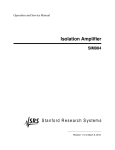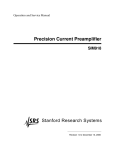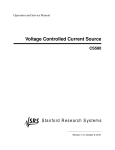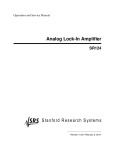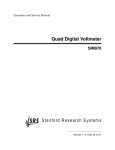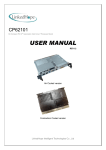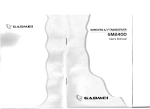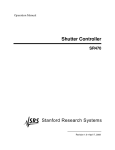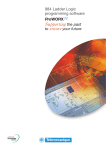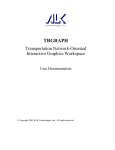Download User`s Manual - Stanford Research Systems
Transcript
Operation and Service Manual Optical Interface Controller SX199 Stanford Research Systems Revision 1.02 • August 6, 2013 Certification Stanford Research Systems certifies that this product met its published specifications at the time of shipment. Warranty This Stanford Research Systems product is warranted against defects in materials and workmanship for a period of one (1) year from the date of shipment. Service For warranty service or repair, this product must be returned to a Stanford Research Systems authorized service facility. Contact Stanford Research Systems or an authorized representative before returning this product for repair. Information in this document is subject to change without notice. c Stanford Research Systems, Inc., 2013 – 2013. All rights reserved. Copyright Stanford Research Systems, Inc. 1290–D Reamwood Avenue Sunnyvale, CA 94089 USA Phone: (408) 744-9040 • Fax: (408) 744-9049 www.thinkSRS.com • e-mail: [email protected] Printed in U.S.A. Document number 9-01692-903 SX199 Optical Interface Controller Contents General Information Safety and Preparation for Use Symbols . . . . . . . . . . . . . Notation . . . . . . . . . . . . . Specifications . . . . . . . . . . 1 2 . . . . . . . . . . . . Introduction 1.1 Introduction to the instrument 1.1.1 Front Panel . . . . . . . 1.1.2 Rear Panel . . . . . . . . 1.2 Remote configuration . . . . . . 1.2.1 IEEE-488 GPIB . . . . . 1.2.2 Ethernet . . . . . . . . . 1.2.3 RS-232 . . . . . . . . . . 1.3 Debug port . . . . . . . . . . . . . . . . . . . . . . . . . . . . . . . . . . . . . . . . . . . . . . . . Remote Operation 2.1 Index of commands . . . . . . . . . . 2.2 Alphabetic list of commands . . . . . 2.3 Introduction . . . . . . . . . . . . . . 2.3.1 Interface configuration . . . . 2.3.2 Buffers . . . . . . . . . . . . . 2.4 Ethernet . . . . . . . . . . . . . . . . 2.5 Link model . . . . . . . . . . . . . . . 2.6 Commands . . . . . . . . . . . . . . . 2.6.1 Command syntax . . . . . . . 2.6.2 Notation . . . . . . . . . . . . 2.6.3 Examples . . . . . . . . . . . 2.6.4 Link commands . . . . . . . . 2.6.5 Interface commands . . . . . 2.6.6 Status commands . . . . . . . 2.7 Status model . . . . . . . . . . . . . . 2.7.1 Status byte (SB) . . . . . . . . 2.7.2 Service request enable (SRE) 2.7.3 Standard event status (ESR) . 2.7.4 Port status event (PSEV) . . . . . . . . . . . . . . . . . . . . . . . . . . . . . . . . . . . . . . . . . . . . . . . . . . . . . . . . . . . . . . . . . . . . . . . . . . . . . . . . . . . . . . . . . . . . . . . . . . . . . . . . . . . . . . . . . . . . . . . . . . . . . . . . . . . . . . . . . . . . . . . . . . . . . . . . . . . . . . . . . . . . . . . . . . . . . . . . . . . . . . . . . . . . . . . . . . . . . . . . . . . . . . . . . . . . . . . . . . . . . . . . . . . . . . . . . . . . . . . . . . . . . . . . . . . iii iii iv v vi . . . . . . . . . . . . . . . . 1–1 . 1–2 . 1–2 . 1–3 . 1–3 . 1–3 . 1–5 . 1–6 . 1–6 . . . . . . . . . . . . . . . . . . . 2–1 . 2–2 . 2–3 . 2–5 . 2–5 . 2–5 . 2–5 . 2–6 . 2–7 . 2–7 . 2–8 . 2–8 . 2–9 . 2 – 11 . 2 – 14 . 2 – 17 . 2 – 18 . 2 – 18 . 2 – 18 . 2 – 19 i ii Contents SX199 Optical Interface Controller General Information Safety and Preparation for Use WARNING Dangerous voltages, capable of causing injury or death, are present in this instrument. Do not remove the product covers or panels. Do not apply power or operate the product without all covers and panels in place. AC line voltage The universal input power supply of the SX199 Optical Interface Controller accommodates any voltage in the range 90 VAC to 260 VAC, with a frequency in the range 47 Hz to 63 Hz. Line cord The SX199 Optical Interface Controller has a detachable, three-wire power cord for connection to the power source and to a protective ground. The chassis of the instrument is connected to the outlet ground to protect against electrical shock. Always use an outlet which has a properly connected protective ground. Fuse The SX199 has an internal fuse that is not intended for service by the user. If the POWER indicator does not illuminate when line power is applied and the power switch is in the “on” position, contact Stanford Research Systems for service. Service The SX199 Optical Interface Controller does not have any user serviceable parts inside. Refer service to a qualified technician. Do not install substitute parts or perform any unauthorized modifications to this instrument. Contact the factory for instructions on how to return the instrument for authorized service and adjustment. iii iv General Information Symbols you may Find on SRS Products Symbol Description Alternating current Caution - risk of electric shock Frame or chassis terminal Caution - refer to accompanying documents Earth (ground) terminal Battery Fuse On (supply) Off (supply) SX199 Optical Interface Controller General Information v Notation The following notation will be used throughout this manual. WARNING A warning means that injury or death is possible if the instructions are not obeyed. CAUTION A caution means that damage to the instrument or other equipment is possible. Typesetting conventions used in this manual are: • Front-panel indicators are set as Overload • Remote command names are set as *IDN? • Literal text other than command names is set as OFF Remote command examples will all be set in monospaced font. In these examples, data sent by the host computer to the SX199 are set as straight teletype font, while responses received by the host computer from the SX199 are set as slanted teletype font. SX199 Optical Interface Controller vi General Information Specifications Rear panel Parameter Optical ports Specification Four (4), Avago “Versatile Link”, duplex, non-latching (mating part HFBR-4506Z) Remote Interfaces RS-232 GPIB Ethernet Debug port DB-9, 9600 / 57.6k baud, switch selected 10/100Base-T (auto) RS-232, DB-9 Optical ports Parameter Wavelength Fiber optic length Specification 660 nm (typ) 3 m standard (HFBR-RMD003Z) 10 m available (HFBR-RMD010Z) General Parameter Temperature Power Dimensions Weight Specification 0 ◦ C to 40 ◦ C, non-condensing 25 W, 90 VAC to 260 VAC, 47 Hz to 63 Hz 8.2500 W × 400 H × 1100 D 5 lbs SX199 Optical Interface Controller 1 Introduction This chapter provides a basic overview of the SX199 Optical Interface Controller. In This Chapter 1.1 1.2 1.3 Introduction to the instrument 1.1.1 Front Panel . . . . . . . 1.1.2 Rear Panel . . . . . . . . Remote configuration . . . . . 1.2.1 IEEE-488 GPIB . . . . . 1.2.2 Ethernet . . . . . . . . . 1.2.3 RS-232 . . . . . . . . . . Debug port . . . . . . . . . . . . . . . . . . . . . . . . . . . . . . . . . . . . . . . . . . . . . . . . . . . . . . . . . . . . . . . . . . . . . . . . . . . . . . . . . . . . . . . . . . . . . . . . . . . . . . . . . . . . . . . . . . . 1–2 1–2 1–3 1–3 1–3 1–5 1–6 1–6 1–1 1–2 1.1 Introduction Introduction to the instrument The SX199 Optical Interface Controller is a communications bridge to connect up to four (4) SRS instruments having a serial optical interface to a computer’s remote interface via GPIB, ethernet, or RS232. 1.1.1 Front Panel The front panel of the SX199 (Figure 1.1) provides simple monitoring of the status of the remote interface and optical port connections. Whenever power is applied and the AC switch in the “ON” position, the ON power indicator should be illuminated. Figure 1.1: The SX199 front panel. Indicators in the left-most column of the “INTERFACE” block indicate real-time data traffic on the three remote interfaces (GPIB, ethernet, and RS-232). Any data coming from or going to an interface will cause that interface indicator to flash. If data is being transmitted to one of the optical ports, then the To Opto indicator will also flash. If data is being received from one of the optical ports, the From Opto will illuminate. Command errors or buffer overruns will cause the ERROR indicator to illuminate. The ERROR indicator is cleared by the remote *ESR? query. When the SX199 is in the “link” state with an optical port, the selected port is indicated by the “PORT” block on the front panel. The corresponding linked remote interface indicator is also illuminated. SX199 Optical Interface Controller 1.2 Remote configuration 1.1.2 1–3 Rear Panel The rear panel of the SX199 (Figure 1.2) provides all external interface connections and the power switch. The unit is turned on when the AC power switch is in the “1” position, and off when the switch is in the “0” position. Figure 1.2: The SX199 rear panel. The optical ports are in the upper block of the rear panel, labeled “Port 1” through “Port 4”. When mating the fiber optic cable to one of the port connections, be sure the small flange protrusion is oriented upwards (Figure 1.3. Once oriented and aligned, press the cable connector inwards until it “clicks” in place (Figure 1.4). 1.2 Remote configuration Remote connection to the SX199 is supported with GPIB, RS-232 and Ethernet computer interfaces. These interfaces are configured by the rear-panel DIP switches. 1.2.1 IEEE-488 GPIB The SX199 comes with an GPIB (IEEE-488) port for communicating over GPIB. The GPIB address is configured with the rightmost five positions of the larger DIP switch block; these position are labled “Bus Address.” The DIP switches encode the GPIB bus address as a binary number in the range 0 to 31. The labels printed around the DIP switch indicate SX199 Optical Interface Controller 1–4 Introduction Figure 1.3: Orientation of optical fiber cable. Figure 1.4: Fully seated optical fiber cable. the polarity: a switch represents a binary ‘0’ in the “up” position or a binary ‘1’ in the “down” position, and the least-significant bit is on the right hand side. A setting of up-up-down-up-down, reading SX199 Optical Interface Controller 1.2 Remote configuration 1–5 left to right on the bus address switches (as shown in Figure 1.2), represents a binary 00101, correspoding to bus address 5 (Figure 1.5). Figure 1.5: Rear panel DIP switch example. The bus address should be set to a value between 1 and 30. If all five switches are in the 1 position, the value is forced to 30, not 31. Any changes made will not take effect until the instrument is power cycled. 1.2.2 Ethernet The SX199 comes standard with an RJ-45 network communications port located on the rear panel. The port may be used to communicate with the SX199 over a 10/100 Base-T ethernet connected network or LAN. The SX199 supports static network configuration as determined by the rear panel DIP switches. Any changes made to the interface configuration will not take effect until the unit is power cycled. The IP Address configuration is primarily selected by positions 2 and 3 of the larger DIP switch. As with the GPIB address selection, a switch either represents a binary ‘0’ in the up position, or a binary ‘1’ in the down position. There are four possible ways to arrange these two switches: 00, 01, 10, and 11. The corresponding configurations are shown in Table 1.1. SX199 Optical Interface Controller 1–6 Introduction Config. Switches IP Address Subnet Mask Gateway 11 10 01 00 Custom Address 192.168.0.(100 + Bus Address) 172.201.25.(100 + Bus Address) 10.0.0.(200 + Bus Address) Custom 255.255.255.0 255.255.0.0 255.0.0.0 Custom 0.0.0.0 0.0.0.0 0.0.0.0 Table 1.1: IP Address configuration These switches give a number of possible static IP addresses that may be useful for your SX199, depending on your network environment. As an example, with the two switches set to 10 (down-up) and the (GPIB) Bus Address set to 5, the IP address will be configured as 192.168.0.105, the subnet mask will be 255.255.255.0, and the default gateway will be 0.0.0.0. Using a remote interface, it is also possible to assign and save custom values for these three parameters. Set the configuration switches to 11 to use your custom value. 1.2.3 RS-232 The RS-232 interface connector is a standard 9 pin, type D, female connector configured as a DCE (transmit on pin 3, receive on pin 2). The communication parameters are: 8 Data bits, 1 Stop bit, No Parity, No Hardware Flow Control. All of these parameters are fixed. The baud rate may be set to either 9600 or 57600 via the leftmost switch on the DIP switch block. Any changes made to the interface configuration will not take effect until the unit is power cycled. 1.3 Debug port In addition to the optical ports and the remote interface connections, the SX199 includes an RS-232 “debugging” port on the rear panel. This connection, like the remote RS-232, is a standard 9 pin, type D, female connector configured as a DCE. The baud rate for the debug port matches the main RS-232 port setting. All data passing through the SX199, whether part of link mode to or from an optical port, or native SX199 commands and queries, is also transmitted out the debug port. This debug stream can be convenient when troubleshooting new user programs or instrument configurations. Error messages from the SX199 are also transmitted on the debug port. SX199 Optical Interface Controller 2 Remote Operation This chapter describes operating the SX199 over the remote interfaces. In This Chapter 2.1 2.2 2.3 2.4 2.5 2.6 2.7 Index of commands . . . . . . . . . Alphabetic list of commands . . . . Introduction . . . . . . . . . . . . . . 2.3.1 Interface configuration . . . . 2.3.2 Buffers . . . . . . . . . . . . . Ethernet . . . . . . . . . . . . . . . . Link model . . . . . . . . . . . . . . Commands . . . . . . . . . . . . . . 2.6.1 Command syntax . . . . . . . 2.6.2 Notation . . . . . . . . . . . . 2.6.3 Examples . . . . . . . . . . . 2.6.4 Link commands . . . . . . . . 2.6.5 Interface commands . . . . . 2.6.6 Status commands . . . . . . . Status model . . . . . . . . . . . . . 2.7.1 Status byte (SB) . . . . . . . . 2.7.2 Service request enable (SRE) 2.7.3 Standard event status (ESR) . 2.7.4 Port status event (PSEV) . . . . . . . . . . . . . . . . . . . . . . . . . . . . . . . . . . . . . . . . . . . . . . . . . . . . . . . . . . . . . . . . . . . . . . . . . . . . . . . . . . . . . . . . . . . . . . . . . . . . . . . . . . . . . . . . . . . . . . . . . . . . . . . . . . . . . . . . . . . . . . . . . . . . . . . . . . . . . . . . . . . . . . . . . . . . . . . . . . . . . . . . . . . . . . . . . 2–2 2–3 2–5 2–5 2–5 2–5 2–6 2–7 2–7 2–8 2–8 2–9 2 – 11 2 – 14 2 – 17 2 – 18 2 – 18 2 – 18 2 – 19 2–1 2–2 2.1 Remote Operation Index of commands Symbol i, j z Definition Unsigned integer Literal token (?) var {var} [var] Required for queries; illegal for set commands Parameter always required Required parameter for set commands; illegal for queries Optional parameter for both set and query forms Link LINK(?) {i} LNKS(?) {i} LNKE(?) {i} LNKG(?) {i} UNLK SESC(?) {i} 2–9 2–9 2 – 10 2 – 10 2 – 10 2 – 10 Link Link Serial Link Ethernet Link GPIB Unlink Set escape character Interface *IDN? TOKN(?) {z} TERM(?) {z} *OPC(?) ULOC(?) {i} IPAD(?) i {, j} NMSK(?) i {, j} GWAY(?) i {, j} MACA? ENET(?) {z} SPAR {z} *RST 2 – 11 2 – 11 2 – 11 2 – 11 2 – 12 2 – 12 2 – 12 2 – 13 2 – 13 2 – 13 2 – 13 2 – 13 Identify Token Mode Response Termination Operation complete Unlock Ethernet IP Address Netmask Default Gateway Ethernet hardware address Ethernet speed Save User Parameters Reset Status *STB? [i] *SRE(?) [i,] {j} *ESR? [i] *ESE(?) [i,] {j} PSEV? [i] PSEN(?) [i,] {j} *CLS LEXE? LCME? 2 – 14 2 – 14 2 – 14 2 – 14 2 – 14 2 – 14 2 – 15 2 – 15 2 – 15 Status byte Service request enable Standard event status Standard event status enable Port status event Port status enable Clear status Last execution error Last command error SX199 Optical Interface Controller 2.2 2.2 Alphabetic list of commands 2–3 Alphabetic list of commands ? *CLS *ESE(?) [i,] {j} *ESR? [i] *IDN? *OPC(?) *RST *SRE(?) [i,] {j} *STB? [i] 2 – 15 2 – 14 2 – 14 2 – 11 2 – 11 2 – 13 2 – 14 2 – 14 Clear status Standard event status enable Standard event status Identify Operation complete Reset Service request enable Status byte E ENET(?) {z} 2 – 13 Ethernet speed G GWAY(?) i {, j} 2 – 13 Default Gateway I IPAD(?) i {, j} 2 – 12 IP Address L LCME? LEXE? LINK(?) {i} LNKE(?) {i} LNKG(?) {i} LNKS(?) {i} 2 – 15 2 – 15 2–9 2 – 10 2 – 10 2–9 Last command error Last execution error Link Link Ethernet Link GPIB Link Serial M MACA? 2 – 13 Ethernet hardware address N NMSK(?) i {, j} 2 – 12 Netmask P PSEN(?) [i,] {j} PSEV? [i] 2 – 14 Port status enable 2 – 14 Port status event S SESC(?) {i} SPAR {z} SX199 Optical Interface Controller 2 – 10 Set escape character 2 – 13 Save User Parameters 2–4 Remote Operation T TERM(?) {z} TOKN(?) {z} 2 – 11 Response Termination 2 – 11 Token Mode U ULOC(?) {i} UNLK 2 – 12 Unlock Ethernet 2 – 10 Unlink SX199 Optical Interface Controller 2.3 2.3 Introduction 2–5 Introduction The SX199 Optical Interface Controller provides buffered, multiplexed communications between the host computer and up to 4 instruments through an optical fiber interface. Data is encoded on the optical fiber as asynchronous serial data using standard UART timing protocol, with 8 data bits, no parity, one stop bit, and 9600 baud. Data polarity on the optical ports is: illuminated = start bit = data “0”. The host computer communicates with the SX199 through the host “remote interface”, which can be either GPIB, ethernet, or RS-232. All remote interfaces are active and available simultaneously on the SX199. Remote operation of the SX199 is through a simple command language documented in this chapter. Both set and query forms of most commands are supported, allowing the user complete control of the controller from a remote computer through the GPIB, RS-232, or ethernet interface. While the SX199 has no direct instrumentation itself, it acts as a “transparent link” to one of up to four downstream instruments connected through the optical fiber interface. 2.3.1 Interface configuration All three remote interfaces have configuration settings that may need adjusting from the rear panel DIP switch. See section 1.2 on page 1 – 3 for configuration of the specific switch settings. 2.3.2 Buffers Except during link mode, the SX199 stores incoming bytes from the remote interfaces in separate 64-byte input buffers. Characters accumulate in the input buffer until a command terminator (hCRi, hLFi, or GPIB-EOI signal) is received, at which point the message is parsed and enqueued for execution. Query responses from the SX199 are buffered in interface-specific 256-byte output queues. If an input buffer overflows, then all data in the input buffer are discarded, and an error is recorded in the ESR status register. 2.4 Ethernet To connect to the SX199 via the ethernet interface, the user must first configure the network parameters. Once connected to local network (or simple ethernet crossover cable), establish a socket connection to TCP/IP port 8888. Send a blank line to initialize the connection, and then send the ULOC 1 command to unlock the ethernet command SX199 Optical Interface Controller 2–6 Remote Operation processor (see page 2 – 12 ). Next, the *IDN? query should be sent. The SX199 should reply with the response string described on page 2 – 11 . 2.5 Link model The SX199 uses a “link” framework for providing communications between a host remote interface and the downstream instruments connected by optical fiber. In this link model, when a “link” is established, a single remote interface is linked to a single optical port: data bytes received from the remote interface are relayed directly to the optical fiber port, and response data received from the optical port are relayed back to the remote interface. While linked, front panel indicators for the selected optical port and the linked remote interface are illuminated. After first establishing a link, it may be necessary to initialize the optical port and the remote interface of the fiber-coupled instrument by sending a hLFi character before beginning remote commanding. The host remote interface(s) that are not linked remain available for regular commanding to the SX199. These interface(s) can be used to reconfigure the link state, or to query status registers of the SX199, or any other remote command documented in this chapter. The linked remote interface, however, will not be processed (parsed) by the SX199—commands transmitted to the SX199 via the linked remote interface will be relayed byte-for-byte to the linked optical port, and not interpreted as SX199 commands. The link state can be exited by transmitting an “escape” character from the host computer to the linked remote interface, followed by any other character. To transmit the escape character to the linked optical port, you must transmit the escape character twice. After reset, the escape character is the “!” character (character code 33). See the SESC command (page 2 – 10 ) for reprogramming the escape character to another byte. SX199 Optical Interface Controller 2.6 2.6 Commands 2–7 Commands This section provides syntax and operational descriptions for remote commands. 2.6.1 Command syntax The four letter mnemonic (shown in CAPS) in each command sequence specifies the command. The rest of the sequence consists of parameters. Commands may take either set or query form, depending on whether the “?” character follows the mnemonic. Set only commands are listed without the “?”, query only commands show the “?” after the mnemonic, and optionally query commands are marked with a “(?)”. Parameters shown in { } and [ ] are not always required. Parameters in { } are required to set a value, and should be omitted for queries. Parameters in [ ] are optional in both set and query commands. Parameters listed without surrounding characters are always required. Do not send ( ) or { } or [ ] as part of the command. Multiple parameters are separated by commas. Multiple commands may be sent on one command line by separating them with semicolons (;) so long as the input buffer does not overflow. Commands are terminated by either hCRi or hLFi characters. Null commands and whitespaces are ignored. Execution of the command does not begin until the command terminator is received. tokens Token parameters (generically shown as z in the command descrip- tions) can be specified either as a keyword or as an integer value. Command descriptions list the valid keyword options, with each keyword followed by its corresponding integer value. For example, to set the response terminator to hLFi, the following two commands are equivalent: TERM LF —or— TERM 2 For queries that return token values, the return format (keyword or integer) is specified with the TOKN command. SX199 Optical Interface Controller 2–8 2.6.2 Remote Operation Notation The following table summarizes the notation used in the command descriptions: 2.6.3 Symbol i, j z Definition Unsigned integer Literal token (?) var {var} [var] Required for queries; illegal for set commands Parameter always required Required parameter for set commands; illegal for queries Optional parameter for both set and query forms Examples Each command is provided with a simple example illustrating its usage. In these examples, all data sent by the host computer to the SX199 are set as straight teletype font, while responses received by the host computer from the SX199 are set as slanted teletype font. The usage examples vary with respect to set/query, optional parameters, and token formats. These examples are not exhaustive, and are intended to provide a convenient starting point for user programming. SX199 Optical Interface Controller 2.6 Commands 2.6.4 2–9 Link commands LINK(?) {i} Link Set or query the optical port link. Setting the LINK i command to a value i between 1 and 4 establishes the link state between optical port i and the remote interface on which the LINK command was received by the SX199. Once executed, that remote interface will now be “linked” — subsequent data received from the host computer on the remote interface will be transmitted to optical port i. To terminate a link session from the linked remote interface, send the escape character followed by any other charater. After reset, the escape character is initially the “!” character (character code 33). The query form LINK? responds with 0 if no link is presently active, or with a two-digit integer rp, where the first digit r is the linked remote interface (1 for RS-232, 2 for GPIB, and 3 for ethernet). The second digit p is the linked optical port, and is a value from 1 to 4. The following query example shows the response when the GPIB interface is linked to optical port 4. Example: LINK? 24 LNKS(?) {i} Link Serial Set (query) the optical port link status for the host RS-232 (serial) port {to optical port i}. Setting LNKS to a value i between 1 and 4 establishes an active link between the RS-232 (serial) remote interface and optical port i. If any other port was previously linked, it disconnects that link in the process. If LNKS is received on the RS-232 remote interface, this is equivalent to the LINK command. Setting LNKS 0 disconnects the link state of the RS-232 (serial) remote interface from any optical port. Note if either of the other two remote interfaces is in the active link state, LNKS 0 has no effect. Example: LNKS 1 SX199 Optical Interface Controller 2 – 10 LNKE(?) {i} Remote Operation Link Ethernet Set (query) the optical port link status for the host ethernet port {to optical port i}. Setting LNKE to a value i between 1 and 4 establishes an active link between the ethernet remote interface and optical port i. If any other port was previously linked, it disconnects that link in the process. If LNKE is received on the ethernet remote interface, this is equivalent to the LINK command. Setting LNKE 0 disconnects the link state of the ethernet remote interface from any optical port. Note if either of the other two remote interfaces is in the active link state, LNKE 0 has no effect. Example: LNKE 1 LNKG(?) {i} Link GPIB Set (query) the optical port link status for the host GPIB port {to optical port i}. Setting LNKG to a value i between 1 and 4 establishes an active link between the GPIB remote interface and optical port i. If any other port was previously linked, it disconnects that link in the process. If LNKG is received on the GPIB remote interface, this is equivalent to the LINK command. Setting LNKG 0 disconnects the link state of the ethernet remote interface from any optical port. Note if either of the other two remote interfaces is in the active link state, LNKG 0 has no effect. Example: LNKG 1 UNLK Unlink This set-only command forces the SX199 to the unlinked state. Note that this command can only be received on a currently-unlinked remote interface. To unlink using the linked remote interface, transmit the escape character ! followed by any other character. Example: UNLK SESC(?) {i} Set escape character Set (query) the escape character {to character code i}. The valid range for i is 0 ≤i< 255. The default value is SESC 33 (the “!” character). Example: SESC? 33 SX199 Optical Interface Controller 2.6 Commands 2.6.5 2 – 11 Interface commands Identify *IDN? Query the SX199 identification string. The response is formatted as: Stanford Research Systems,SX199,s/n******,ver#.## where ****** is the 6-digit serial number, and #.## is the firmware revision level. Example: *IDN? Stanford Research Systems,SX199,s/n098023,ver1.01 TOKN(?) {z} Token Mode Set (query) the token response mode {to z=(OFF 0, ON 1)}. Token response mode controls the formatting of response messages generated by the SX199 to remote queries of token-type values. When TOKN OFF, the SX199 responds with the numeric version of the token quantity. When TOKN ON, the text version is returned. Example: TOKN? ON TERM(?) {z} Response Termination Set (query) the token response mode {to z=(NONE 0, CR 1, LF 2, CRLF 3, LFCR 4)}. Response messages generated by the SX199 will be terminated by the 0-, 1- or 2-character termination sequence specified by TERM. Note that the TERM command is interface specific. In other words, if TERM LF is received on the RS-232 interface, and then TERM CRLF is received on the ethernet interface, then queries received on the RS232 interface shall generate response messages terminated with the LF character, while queries received on the ethernet interface shall generate response messages terminated by the CR and LF characters. Example: TERM LF *OPC(?) Operation complete The set form, *OPC, will set the OPC bit in the Standard Event Status register; the query form, *OPC?, will return the value 1. *OPC is useful for pacing streams of remote commands; the *OPC command will not be processed by the command execution of the SX199 until all preceding commands have been executed. SX199 Optical Interface Controller 2 – 12 Remote Operation Example: *OPC? 1 ULOC(?) {i} Unlock Ethernet Set (query) the ethernet command lockout {to i}. Upon power-up, the SX199 defaults to ULOC 0, which locks out all remote commanding over the ethernet port. To enable ethernet control, send the command ULOC 1. When first connecting to the ethernet command port (port 8888), the user’s application program should begin by sending ULOC 1. The ULOC command is the only command that can be processed over ethernet while ULOC 0. Example: ULOC 1 IPAD(?) i {, j} IP Address Set (query) byte i of the “Custom” internet address {to j}. Note that byte 0 is the left-most byte of the address. This address is used when the rear-panel DIP switches are in the “11” (down-down) position. Also note that changes to IPAD are not saved until the SPAR 0 command is issued. Example: IPAD?0; IPAD?1; IPAD? 2; IPAD?3 169;254;46;27 NMSK(?) i {, j} Netmask Set (query) byte i of the “Custom” internet network mask {to j}. Note that byte 0 is the left-most byte of the mask. This address is used when the rear-panel DIP switches are in the “11” (down-down) position. Also note that changes to NMSK are not saved until the SPAR 0 command is issued. Example: NMSK 1, 255; NMSK?0; NMSK?1; NMSK?2; NMSK3 255;255;0;0 SX199 Optical Interface Controller 2.6 Commands GWAY(?) i {, j} 2 – 13 Default Gateway Set (query) byte i of the internet default gateway {to j}. Note that byte 0 is the left-most byte of the address. This address is used when the rear-panel DIP switches are in the “11” (down-down) position. Also note that changes to GWAY are not saved until the SPAR 0 command is issued. Example: GWAY 0, 172 Ethernet hardware address MACA? Query the low-level ethernet hardware address (MAC address). This is not the same as the IP address, and cannot be changed by the user. Example: MACA? 0019:b303:ffff ENET(?) {z} Ethernet speed Set (query) the ethernet speed{to z=(AUTO 0, M10 1, M100 2)}. The ethernet speed can be set to 100Base-T (z = M100), 10Base-T (z = M10), or autonegotiate between the two speeds (z = AUTO). Example: ENET? 0 SPAR {z} Save User Parameters Save user settings to non-volatile memory. The token z should always be 0. This command is needed to record changes to internet address before power cycling. Example: SPAR 0 *RST Reset Reset the SX199 to its default configuration. The following commands are internally excecuted upon receipt of the *RST command: • UNLK • TOKN OFF Note that *RST does not modify the SESC setting, or any of the status enable register values. SX199 Optical Interface Controller 2 – 14 Remote Operation Example: *RST 2.6.6 Status commands *STB? [i] Status byte Reads the Status Byte register [bit i]. Example: *STB? 0 *SRE(?) [i,] {j} Service request enable Set (query) the Service Request Enable register [bit i] {to j}. Example: *SRE 0,1 *ESR? [i] Standard event status Reads the Standard Event Status Register [bit i]. Upon executing *ESR?, the returned bit(s) of the ESR register are cleared. Example: *ESR? 64 *ESE(?) [i,] {j} Standard event status enable Set (query) the Standard Event Status Enable Register [bit i] {to j}. Example: *ESE 6,1 ESE? 64 PSEV? [i] Port status event Reads the Port Status Event Register [bit i]. Upon executing PSEV?, the returned bit(s) of the PSEV register are cleared. Example: PSEV? 4 PSEN(?) [i,] {j} Port status enable Set (query) the Port Status Enable Register [bit i] {to j}. Example: PSEN 3,1 PSEN? 4 SX199 Optical Interface Controller 2.6 Commands *CLS 2 – 15 Clear status *CLS immediately clears the ESR register and the PSEV register. Example: *CLS LEXE? Last execution error Query the last execution error code. A query of LEXE? always clears the error code, so a subsequent LEXE? will return 0. Valid codes are: Value 0 1 2 3 4 5 Definition No execution error since last LEXE? Illegal value Wrong token Invalid bit Queue full Not compatible Example: LNKG 7; LEXE?; LEXE? 1;0 The error (1, “Illegal value,”) is because the parameter value (7) is too large for LNKG. The second read of LEXE? returns 0. LCME? Last command error Query the last command error code. A query of LCME? always clears the error code, so a subsequent LCME? will return 0. Valid codes are: Value 0 1 2 3 4 5 6 7 8 9 10 11 12 13 14 Example: *IDN LCME? SX199 Optical Interface Controller Definition No execution error since last LCME? Illegal command Undefined command Illegal query Illegal set Missing parameter(s) Extra parameter(s) Null parameter(s) Parameter buffer overflow Bad floating-point Bad integer Bad integer token Bad token value Bad hex block Unknown token 2 – 16 Remote Operation 4 The error (4, “Illegal set”) is due to the missing “?”. SX199 Optical Interface Controller 2.7 2.7 Status model 2 – 17 Status model status registers The SX199 status registers follow the hierarchical IEEE–488.2 format. A block diagram of the status register array is given in Figure 2.1. Standard Event Status undef undef CME: Command error 5 EXE: Execution error 4 5 DDE: Device error 3 3 4 undef INP: Input overflow 1 OPC: Operation c omplete 0 ESR 1 0 Status Byte 7 7 undefined 6 X MSS: Master Summary Status 5 5 ESB: Event Status Bit 4 4 undefined 3 3 undefined 2 2 undefined 1 1 undefined 0 SB ESE 0 PSSB: Port Status Summary Bit SRE Port Status undef undef undef undef Port 4 3 3 Port 3 2 Port 2 1 2 Port 1 0 0 PSEV 1 PSEN Figure 2.1: Status Model for the SX199 Optical Interface Controller There are three categories of registers in the status model of the controller: Event Registers : These read-only registers record the occurrence of defined events within the controller. If the event occurs, the corresponding bit is set to 1. Upon querying an event register, any set bits within it are cleared. These are sometimes known as “sticky bits,” since once set, a bit can only be cleared by reading its value. Event register names end with SR or EV. Enable Registers : These read/write registers define a bitwise mask for their corresponding event register. If any bit position is set in an event register while the same bit position is also set in the enable register, then the corresponding summary bit message is set in the Status Byte. Enable register names end with SE or EN. SX199 Optical Interface Controller 2 – 18 Remote Operation Status Byte : This read-only register represents the top of the status model, and is populated with summary bit messages and interface condition bits. Enabled bits within the Status Byte generate the remote Request Service event. At power-on, all status registers are cleared. 2.7.1 Status byte (SB) The Status Byte is the top-level summary of the SX199 status model. When enabled by the Service Request Enable register, a bit set in the Status Byte causes the MSS (Master Summary Status) bit to be set. Weight Bit 1 2 4 8 16 32 64 128 0 1 2 3 4 5 6 7 Flag PSSB undef (0) undef (0) undef (0) undef (0) ESB MSS undef (0) PSSB : Port Status Summary Bit. Indicates whether one or more of the enabled event bits in the Port Status Event Register is true. ESB : Event Status Bit. Indicates whether one or more of the enabled events in the Standard Event Status Register is true. MSS : Master Summary Status. Indicates whether one or more of the enabled status messages in the Status Byte register is true. This register is read with the *STB? query. 2.7.2 Service request enable (SRE) Each bit in the SRE corresponds one-to-one with a bit in the SB register, and acts as a bitwise AND of the SB flags to generate MSS. Bit 6 of the SRE is undefined—setting it has no effect, and reading it always returns 0. This register is set and queried with the *SRE(?) command. At power-on, this register is cleared. 2.7.3 Standard event status (ESR) The Standard Event Status Register consists of 8 event flags. These event flags are all “sticky bits” that are set by the corresponding events, and cleared only by reading or with the *CLS command. Reading a single bit (with the *ESR? i query) clears only Bit i. SX199 Optical Interface Controller 2.7 Status model 2 – 19 Weight Bit 1 2 4 8 16 32 64 128 0 1 2 3 4 5 6 7 Flag OPC INP undef (0) DDE EXE CME undef (0) undef (0) OPC : Operation Complete. Set by the *OPC command. INP : Input Overflow. Indicates data in one of the remote interface input buffers has been lost due to buffer overflow. DDE : Device-Dependent Error. queue overflow. Indicates an internal command EXE : Execution Error. Indicates the error in a command that was successfully parsed. Out-of-range parameters are an example. CME : Command Error. Indicates a command parser-detected error. 2.7.3.1 Standard event status enable (ESE) The ESE acts as a bitwise AND with the ESR register to produce the single-bit ESB message in the Status Byte Register (SB). The register can be set and queried with the *ESE(?) command. At power-on, this register is cleared. 2.7.4 Port status event (PSEV) The Port Status Event Register consists of 4 event flags. These event flags are all “sticky bits” that are set by the corresponding events, and cleared only by reading or with the *CLS command. Reading a single bit (with the PSEV? i query) clears only Bit i. Weight Bit 1 2 4 8 16 32 64 128 0 1 2 3 4 5 6 7 Flag Port 1 Port 2 Port 3 Port 4 undef (0) undef (0) undef (0) undef (0) The four defined bits in PSEV correspond one-for-one with the four optical ports. A bit is set in PSEV when the corresponding optical port asserts the “status message” by driving a serial “break” signal SX199 Optical Interface Controller 2 – 20 Remote Operation on the optical port. This is the method available for optical port remote instruments to request service asynchronously. 2.7.4.1 Port status event enable (PSEN) The PSEN acts as a bitwise AND with the PSEV register to produce the single-bit PSSB message in the Status Byte Register (SB). The register can be set and queried with the PSEN(?) command. At power-on, this register is cleared. SX199 Optical Interface Controller


































